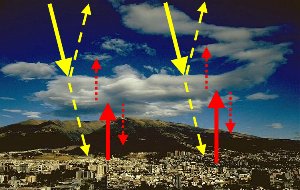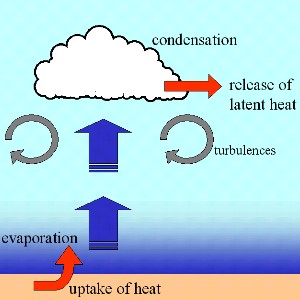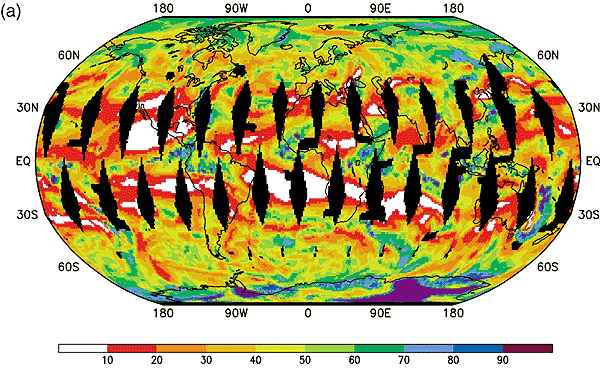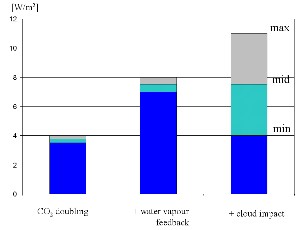 > ENC Master > Climate Encyclopaedia > Lower Atmosphere > more > 2. Radiation & greenhouse gases > - water
> ENC Master > Climate Encyclopaedia > Lower Atmosphere > more > 2. Radiation & greenhouse gases > - water
 |
|
|
|
Lower AtmosphereRead more |
Water vapour and cloudsWater vapour is known to be the most important greenhouse gas accounting for about 60% 1 of the greenhouse effect. So far the water vapour concentration has been assumed to be more or less constant and not to contribute to an additional greenhouse effect. This will change with the future warming of the Earth ...
|
|
Probably the greatest uncertainty in future projections of climate arises from the water vapour feedback as well as from clouds and their interaction with radiation.
|
|
Generally it can be predicted, that an increasing air temperature leads to increasing evaporation and therefore to a higher amount of water vapour in the air. While ideal thermodynamic conditions are nearly fullfilled for evaporation processes in the boundary layer of the troposphere (up to 1-2 km), the modelling of the free troposphere is more complicated and here is the major greenhouse potential of a water vapour increase.
|
|
Cloud formationThe consequence of increasing humidity is an increasing cloud cover. Clouds interact in two ways with radiation. On the one hand, they act like a greenhouse gas, absorb long wave radiation and send it back to the Earth. On the other hand they increase the Earth's albedo and scatter sunlight back to the space before it reaches the Earth. It strongly depends on the type of clouds, which effect is dominant. High clouds contribute to an additional warming, while low cloud reflect more sunlight and lead to a cooling.
|
Twofold feedbackThe increase of water vapour and the cloud formation may lead to antipodal feedback on further warming of the Earth as shown in the following scheme. However it is not sure so far that the total impact of cloud formation will really be negative. Different models come to different conclusions (see IPCC TAR 2001, 7.2.2.5).
|
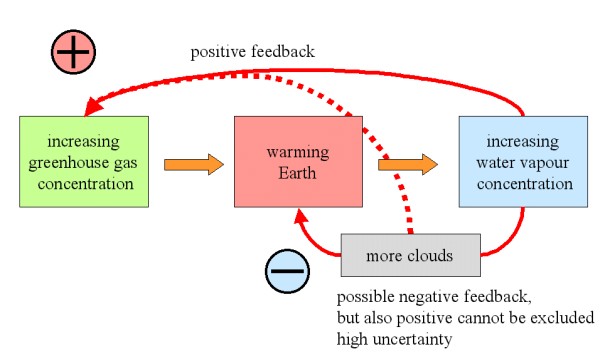 |
|
3. Feedbacks in the water cycle: Since global warming leads to increasing water vapour concentrations and more water vapour leads to further warming, we could have an amplification of the effect. Increasing cloud formation could counteract this effect. But in particular high clouds have a positive effect as well (dotted arrow). Our knowledge about clouds is not yet sufficient in order to explain how exactly the balance will be reached.
|
UncertaintiesCloud formation and strong differences in water vapour concentrations occur on a regional scale which falls below the grid size of climate models. Our climate models are too coarse to take into account every cloud appearing over a big lake or due to slope winds on hot summer days. Many uncertainties come from the dependence on: |
- large scale dynamics The atmosphere is a very dynamic system and far away from a simple equilibrium. Depending on the latitude transport of moisture is driven by different processes:
|
|
|
|
Estimations of the water vapour and cloud feedbackCurrent estimations say, that for a doubling of CO2 in the air, i.e. a mixing ration of 560 ppm compared to the preindustrial value of 280 ppm (we had 370 ppm in 2001), the temperature increase will range between 1.5 - 4.5°C. This wide range is mainly due to the uncertainty of the effect of cloud formation.
|
The doubling of CO2 without any other change would lead to an additional radiative forcing of 3.5-4 W/m2 (i.e. an temperature increase of 1.2°C). Taking into account the estimations of the feedback of gaseous water only, this value would roughly double (7-8 W/m2). At this point, the impact of clouds has to be added, which may either lead to a slight cooling (regarded as more likely) or to an additional warming. The uncertainty range is estimated to be between -3 and +3 W/m2. This leads to an radiative forcing of about 4-11 W/m2 if CO2 doubles or a temperature increase between 1.5 and 4.5 °C. If you compare this to the 1.2°C which would come from a CO2 doubling without other feedback you get an idea of what importance a better understanding of the water vapour impact for climate modelling is.
|
|
1 Some references even say, that water in the troposphere including the long wave absorption of clouds account for about 80% of the natural greenhouse effect (Curry&Webster, Thermodynamics of Atmospheres and oceans, Academic Press, 1999). |
|
Related pages: You find more about the interaction of clouds and radiation and its climate impact in:
|
About this page:author: Elmar Uherek - Max Planck Institute, Mainz
|


